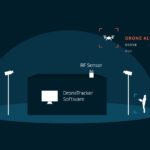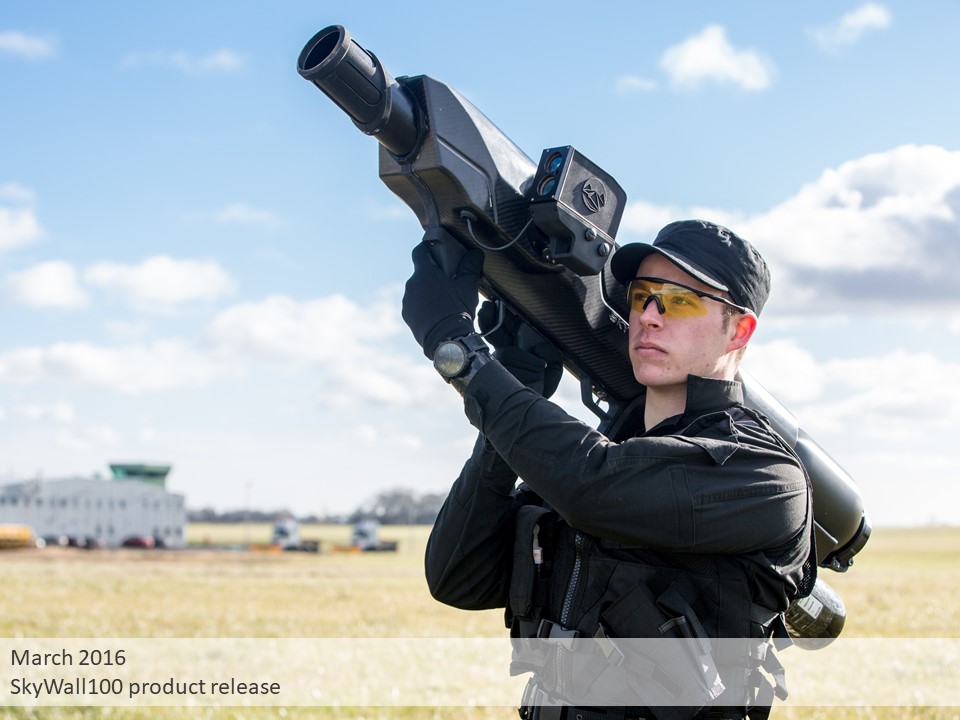
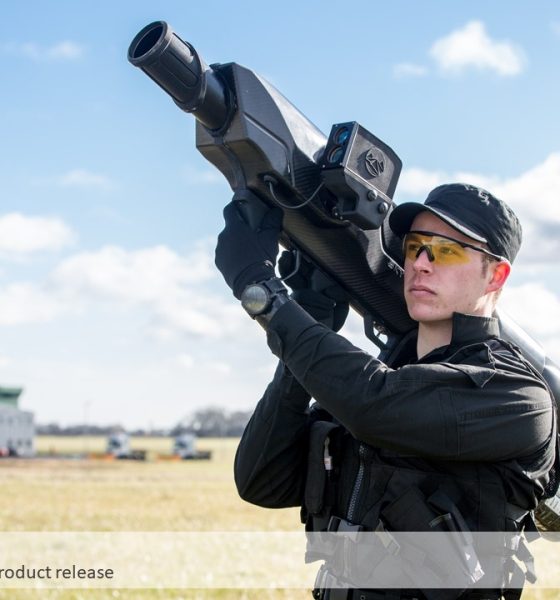
Lifestyle
Anti-drone defense in focus as airport endangerment episodes rise
In the wake of the drone sightings at London’s Gatwick Airport, an incident which grounded and delayed planes for 32 hours during the Christmas travel rush this past December, the issue of anti-drone defense is receiving serious attention from regulators. Recent studies on the issue are showing the loopholes – according to a recent UK Airprox Board (UKAB) report, around 120 near misses between drones and aircraft were reported across the UK in the last year alone. In the US, the Federal Aviation Administration (FAA) receives over 100 reports every month of unauthorized drone activity around aircraft. While the future of drone tech has exciting possibilities, the security response will clearly need to grow with it, and the US and UK governments are stepping up their roles in the issue as commercial products expand their solutions.
The United Kingdom’s parliamentary leadership has recently called on all airports to make greater efforts in securing their facilities from the unauthorized small craft flights, specifically by investing in technology that will identify their presence and remedy it immediately. In response, military-grade anti-drone equipment has already been installed at several airports across the country. In the U.S., a pilot program has been launched by the FAA in collaboration with NASA to determine ways to integrate drones (or more broadly Unmanned Aerial Systems (UAS)) with current airspace traffic. Additionally, proposals will be coming soon for more drone rules that balance security concerns with innovation.
Unauthorized flights by hobbyists in airport spaces, potentially including those with bad intentions in the future, are a serious security risk, even deceptively so given the size difference between passenger aircraft and the typical commercial drone. Cockpit collisions and engine damage could have catastrophic results, something seen in aviation over the years with birds (see: “miracle on the Hudson”). In the wider realm, considering the growing capabilities of drones to carry larger payloads and have longer flight times, the potential security issues increase with the imagination – just about anything that could be a positive service for consumers could be modified into a nefarious one: illegal drug deliveries, spying, hacking, etc. Of course, drones falling onto unsuspecting heads below is also a serious concern.
- The Skywall 100 anti-drone device. | Credit: OpenWorks Engineering Ltd.
- The DroneGun Tactical, an anti-drone device. | Credit: DroneShield
- An overview of the Dedrone DroneTracker system. | Credit: Dedrone
Some of the anti-drone solutions already on the market to assist with the emerging security issues arising from this developing technology are as interesting as the drones themselves. One such tech, called “DroneGun Tactical“, looks like a military rifle and works by jamming the communication signals between drones and their pilots, immediately ceasing video transmission as well. It’s designed to keep drone payloads intact so sensitive cargo (i.e., explosives) can be safely controlled and origination information can be retrieved. A similar product called the “IXI Dronekiller” has a similar function. Another firearm-styled anti-drone tech called “SkyWall100” allows operators to physically capture offending drones and has been previously used for presidential-level security operations.
On the larger scale tracking front, one of the major companies in the anti-drone solution business is Dedrone Inc., a venture using AI-driven tracking software. Dedrone’s technology combines sensors and machine learning to detect, identify, and alert clients of all craft in designated airspace. The system can distinguish between drones, birds, planes, and other moving objects, including the specific drone models being flown, providing additional information for security teams to locate the craft’s origin and determine its threat level. Similar technology such as Fortem Technologies’ “SkyDome” also provides airspace-specific security coverage. Dedrone additionally provided a situational awareness report to 4 UK airports wherein 285 drones were detected in their respective areas over the course of about 5 months, the findings of which further underscored the problem at Gatwick last month.
For whatever reason, the threat warnings regarding drones from those in the security industry haven’t merited responses like the ones now being seen following the UK airport incidence and subsequent revelations. The UKAB report also revealed 18 previously unknown near-misses between drones and airliners last year in the country. Previous crashes – including an airliner-drone nose collision on a Boeing 747 Aeromexico flight, an Army helicopter-drone hit, a small passenger plane-drone strike and a helicopter crash landing after a drone evasion – over the last couple of years weren’t determined by the FAA to be results of “catastrophic” drone risks. Perhaps 1,000 grounded flights affecting 140,000 passengers created enough of a Twitter storm to garner the needed attention.
The embrace of drone technology across multiple industries has already begun. In search and rescue efforts, the crafts have been used to locate missing hikers and accident victims. Retail giants like Amazon are testing consumer deliveries via drone, and hospitals are looking into organ transportation to expand donor organ availability. As with all new technologies, there will be growing pains – remotely controlled hobbyist and professional devices taking to the skies unsurprisingly are no exception.

Lifestyle
Tesla Model S Plaid battles China’s 1500 hp monster Nurburgring monster, with surprising results
There is just something about Tesla’s tuning and refinement that makes raw specs seem not as game-changing.
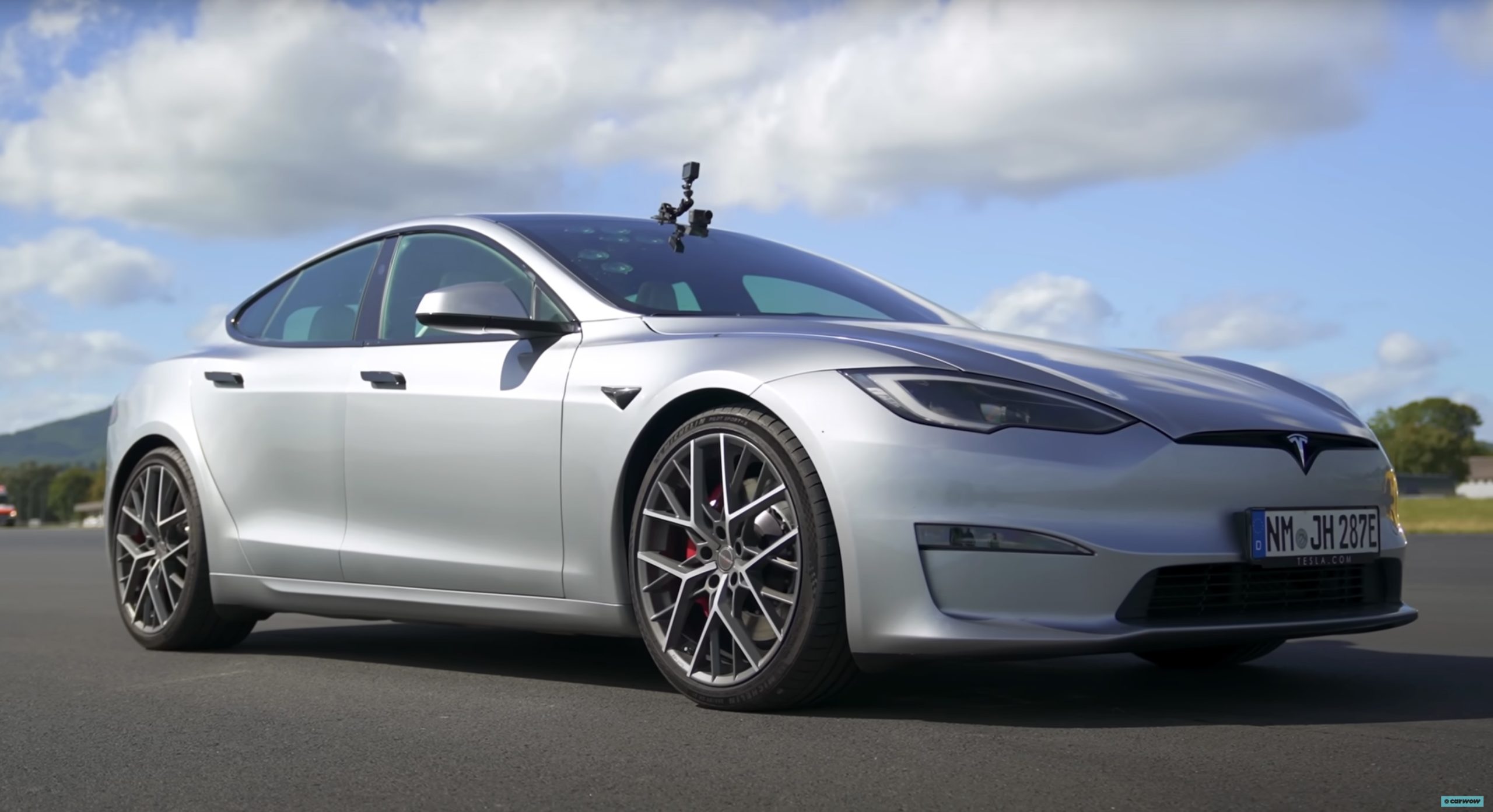
The Tesla Model S Plaid has been around for some time. Today, it is no longer the world’s quickest four-door electric sedan, nor is it the most powerful. As per a recent video from motoring YouTube channel Carwow, however, it seems like the Model S Plaid is still more than a match for some of its newer and more powerful rivals.
The monster from China
The Xiaomi SU7 Ultra is nothing short of a monster. Just like the Model S Plaid, it features three motors. It also has 1,548 hp and 1,770 Nm of torque. It’s All Wheel Drive and weighs a hefty 2,360 kg. The vehicle, which costs just about the equivalent of £55,000, has been recorded setting an insane 7:04.957 at the Nurburgring, surpassing the previous record held by the Porsche Taycan Turbo GT.
For all intents and purposes, the Model S Plaid looked outgunned in Carwow’s test. The Model S Plaid is no slouch with its three motors that produce 1,020 hp and 1,420 Nm of torque. It’s also a bit lighter at 2,190 kg despite its larger size. However, as the Carwow host pointed out, the Model S Plaid holds a 7:25.231 record in the Nurburgring. Compared to the Xiaomi SU7 Ultra’s record, the Model S Plaid’s lap time is notably slower.
Real-world tests
As could be seen in Carwow’s drag races, however, Tesla’s tech wizardry with the Model S Plaid is still hard to beat. The two vehicles competed in nine races, and the older Model S Plaid actually beat its newer, more powerful counterpart from China several times. At one point in the race, the Xiaomi SU7 Ultra hit its power limit due to its battery’s temperature, but the Model S Plaid was still going strong.
The Model S Plaid was first teased five years ago, in September 2020 during Tesla’s Battery Day. Since then, cars like the Lucid Air Sapphire and the Xiaomi SU7 Ultra have been released, surpassing its specs. But just like the Model Y ended up being the better all-rounder compared to the BYD Sealion 7 and the MG IM6, there is just something about Tesla’s tuning and refinement that makes raw specs seem not as game-changing.
Check out Carwow’s Model S Plaid vs Xiaomi SU7 drag race video below.
Lifestyle
500-mile test proves why Tesla Model Y still humiliates rivals in Europe
On paper, the BYD Sealion 7 and MG IM6 promised standout capabilities against the Model Y.

BYD is seeing a lot of momentum in Europe, so much so that mainstream media has taken every opportunity to argue that the Chinese automaker has beaten Tesla in the region. But while BYD sales this year in Europe are rising and Tesla’s registrations remain challenged, the raw capabilities of vehicles like the Model Y are difficult to deny.
This was highlighted in a 500-mile challenge by What Car? magazine, which showed that the new Tesla Model Y is more efficient, cheaper to run, and more reliable than rivals like the BYD Sealion 7, and even the nearly 400 KW-charging MG IM6.
Range and charging promises
On paper, the BYD Sealion 7 and MG IM6 promised standout capabilities against the Model Y. The Sealion 7 had more estimated range and the IM6 promised significantly faster charging. When faced with real-world conditions, however, it was still the Model Y that proved superior.
During the 500-mile test, the BYD nearly failed to reach a charging stop, arriving with less range than its display projected, as noted in a CarUp report. MG fared better, but its charging speeds never reached its promised nearly-400 kW charging speed. Tesla’s Model Y, by comparison, managed energy calculations precisely and arrived at each stop without issue.
Tesla leads in areas that matter
Charging times from 25% to 80% showed that the MG was the fastest at 17 minutes, while Tesla and BYD were close at 28 and 29 minutes, respectively. Overall efficiency and cost told a different story, however. The Model Y consumed 19.4 kWh per 100 km, compared to 22.2 for MG and 23.9 for BYD. Over the full trip, Tesla’s charging costs totaled just £82 thanks to its supercharger network, far below BYD’s £130 and MG’s £119.
What Car? Magazine’s testers concluded that despite BYD’s rapid sales growth and the MG IM6’s seriously impressive charging speeds, Tesla remains the more compelling real-world choice. The Model Y just offers stability, efficiency, and a proven charging infrastructure through its Supercharging network. And as per the magazine’s hosts, the Model Y is even the cheapest car to own among the three that were tested.
Watch What Car? Magazine’s 500-mile test in the video below.
Lifestyle
Tesla Cybertruck slapped with world’s least intimidating ticket, and it’s pure cringe
One cannot help but cringe and feel second-hand embarrassment at the idea of a person just driving around with a stack of these babies.
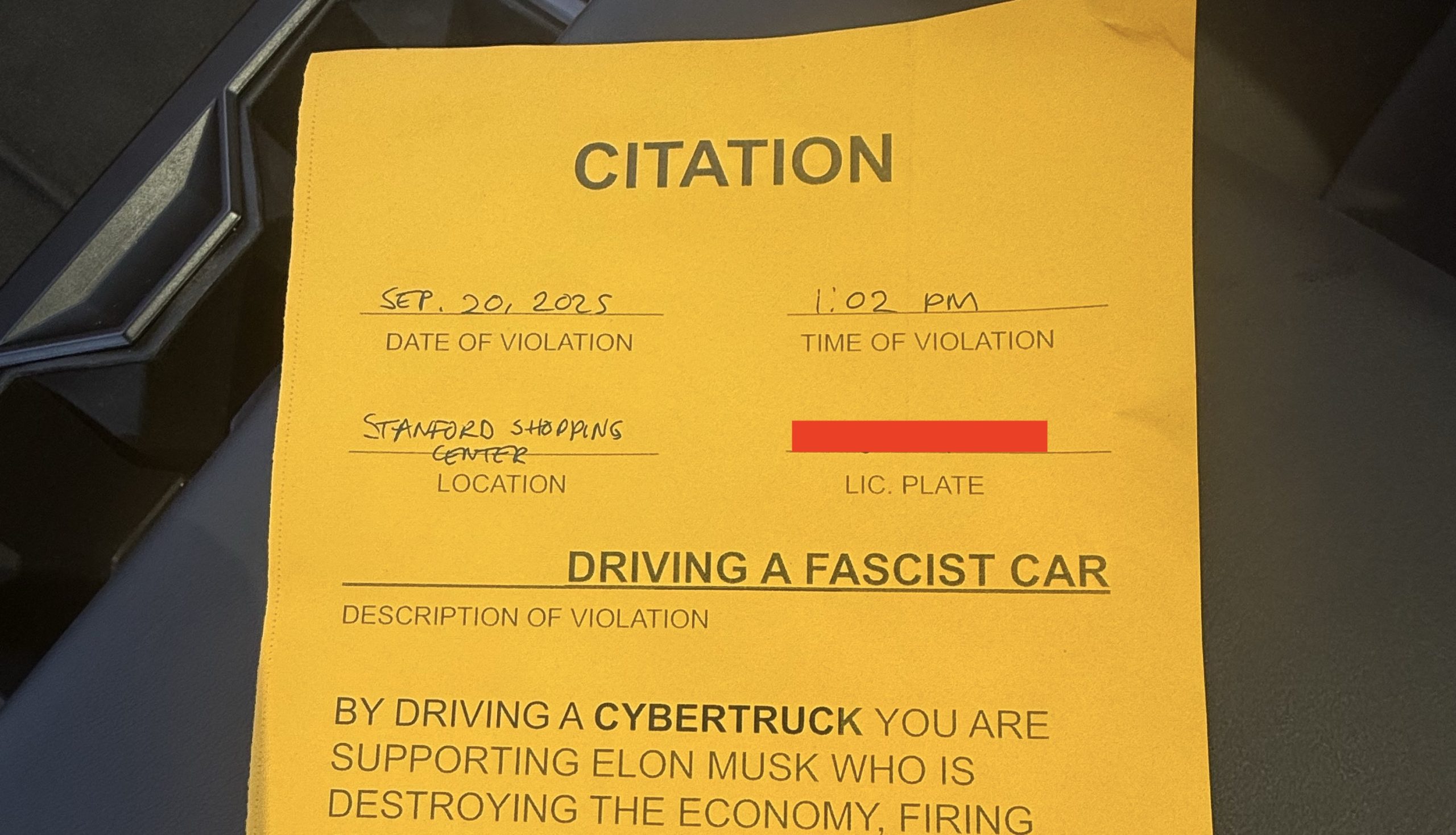
A Cybertruck parked at Stanford Shopping Center in California was recently hit with what might be the most try-hard piece of paper ever slipped under a wiper blade: a “fake citation” accusing the driver of supporting a “fascist car.”
The note, shared on X by Tesla staff program manager Ryan Torres, quickly made the rounds on X, where it quickly gained attention as an example of how not to protest.
The world’s least intimidating ticket
According to the citation, the supposed “violation” was “driving a fascist car.” The remedial action? Take the bus, call an Uber, or ride a bike. The note also dubbed Elon Musk a “chainsaw-wielding Nazi billionaire.” Now, protests against Tesla and Elon Musk have become commonplace this year, but one cannot help but cringe and feel second-hand embarrassment at the idea of a person just driving around with a stack of fake anti-Tesla/Musk citations.
Torres pointed out the irony himself in his post on X. Tesla currently employs over 140,000 Americans, and SpaceX has put the U.S. firmly back at the top of space technology. As Torres put it, maybe the person behind the world’s least intimidating ticket should “read a book on innovation before vandalizing” other people’s property.
Peak performative clownery
Not to mention that the fake ticket’s logic collapses under its own weight. EVs like the Cybertruck are literally designed to reduce emissions, not “destroy the economy.” If anything, Tesla has bolstered the United States’ economy by fueling jobs in engineering, manufacturing, and clean energy. It’s not the first time a Tesla has been the target of vandalism or politically charged notes, but this one stands out for sheer cringe value.
Torres summed it up neatly: “Peak clownery.” On that point, at least, the citation earns full marks. In a way, though, perhaps cringe fake tickets are not as bad as the literal firebombs that were being thrown at Tesla stores and cars earlier this year because some critics were gleefully misinformed about Elon Musk.


